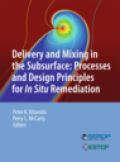
Delivery and mixing in the subsurface: processes and design principles for in situ remediation
Kitanidis, Peter K.
McCarty, Perry L.
This volume is meant to provide the practitioner with information on the natural mixing processes occurring in aquifers as well as to describe basic strategies that can be implemented to enhance mixing in particular cases. For example, when it comes to mixing miscible liquids, one can speed up mixing in the formation by manipulating the flow such as through the use of recirculation wells. Furthermore, much of the mixing can be achieved partially within recirculation wells themselves, where contaminated water is admixed with additives, volatile products may be removed through a vapor mass exchanger, etc. Thus, addingmixing wells can significantly increase the performance of the delivery and mixing system and speed up the process of remediation. Emphasis on what the practitioner needs to know about delivery and mixing in the subsurface. Describes the principles of chemical delivery and mixing systems and their design and implementation for effective in situ remediation. Numerous case studies are provided to give readers real examples of the topics at hand. INDICE: Preface. About the Editors. External Reviewers. Introduction. Transport and Mixing. Hydrogeochemical Models. Travel-Time Based Reactive Transport Modeling for in situ Subsurface Reactor. Recirculation Systems. Permeable Barrier Walls. In situ Sparging for Delivery of Gases in the Subsurface. Intrinsic Remediation in Natural-Gradient Systems. Source Remediation Challenges. Appendix A. Appendix B. Appendix C. Index.
- ISBN: 978-1-4614-2238-9
- Editorial: Springer New York
- Encuadernacion: Cartoné
- Páginas: 346
- Fecha Publicación: 28/02/2012
- Nº Volúmenes: 1
- Idioma: Inglés
